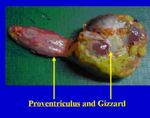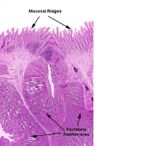Difference between revisions of "Proventriculus - Anatomy & Physiology"
Jump to navigation
Jump to search
m |
|||
| Line 16: | Line 16: | ||
*Secretes digestive enzymes | *Secretes digestive enzymes | ||
| − | *Contacts the left lobe of the liver ventrally and laterally | + | *Contacts the left lobe of the [[Avian Liver - Anatomy & Physiology|liver]] ventrally and laterally |
*Related dorso-caudally to the [[Spleen - Anatomy & Physiology|spleen]] | *Related dorso-caudally to the [[Spleen - Anatomy & Physiology|spleen]] | ||
Revision as of 15:04, 23 July 2008
Introduction
The proventriculus is also referred to as the muscular stomach. It is connected by the isthmus to the gizzard.
Structure and Function
- A storage organ in fish and flesh eating birds
- Appropriate to a soft diet
- Secretes digestive enzymes
- Contacts the left lobe of the liver ventrally and laterally
- Related dorso-caudally to the spleen
- More cranial than the gizzard
- Lies to the left of the midline of the bird
- Spindle/fusiform shaped
- Roughly 4cm long
- Lumen diameter similar to the oesophagus
- No oesophageal sphincter
Histology
- Mucous cells
- Columnar epithelium
- Basolphilic
- Papillae- through which collecting ducts from glands run
- Lamina propria run into the papillae
- Hydrochloric acid and pepsin produced
- Glands in the submucosa
- Single tubular glands are grouped into lobules with a common opening into a papillae
- Serous membrane of mesothelial cells attached to the outer longitudinal layer of muscle
- 3 layers of lamina muscularis
- No parietal cells

